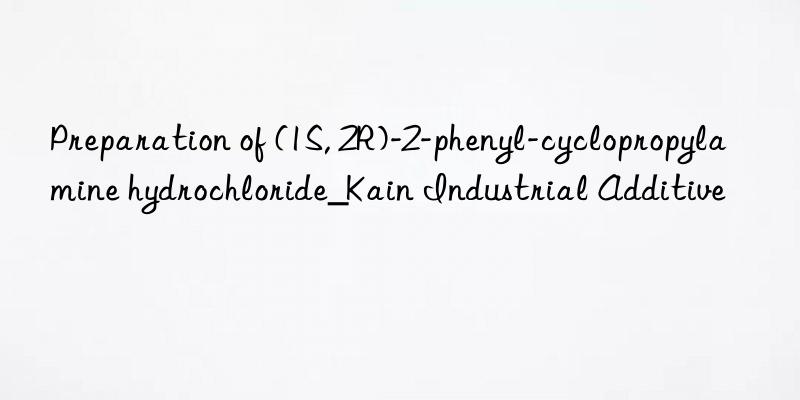
Background and overview[1]
(1S, 2R)-2-phenyl-cyclopropylamine hydrochloride can be used as a pharmaceutical synthesis intermediate. If (1S, 2R)-2-phenyl-cyclopropylamine hydrochloride is inhaled, move the patient to fresh air; if skin contact occurs, remove contaminated clothing and wash skin thoroughly with soap and water, if any If you feel discomfort, seek medical attention; if eye contact occurs, separate eyelids, rinse with running water or saline, and seek medical attention immediately; if ingested, rinse mouth immediately, do not induce vomiting, and seek medical attention immediately.
Preparation[1]
The preparation of (1S, 2R)-2-phenyl-cyclopropylamine hydrochloride is divided into the following steps:
Step 1: General procedure for the synthesis of trans and cis 2-phenylcyclopropylcarboxylic acids (4a-c and 5a-c). Example: trans 2-(4-nitrophenyl)cyclopropylcarboxylic acid (4c). A solution of 2c (9.95 mmol, 2.34 g) and 2NKOH (19.9 mmol, 1.12 g) in ethanol (30 mL) was stirred at room temperature overnight. The reaction was quenched by adding 2 N HCl until pH = 2, then the precipitate was filtered, washed with water (3 × 30 mL) and dried to give pure 4c as a light yellow solid. Compound 4a. The yield is 93%. Melting point: 93-95℃
Step 2: General/Typical Procedure: General procedure for the synthesis of trans and cis tert-butyl 2-(4-nitrophenyl)cyclopropylcarbamate (6a-c and 7a-c). Example: trans-tert-butyl 2-(4-nitrophenyl)cyclopropylcarbamate (6c). 4c (5.3 mmol, 1.1 g) was dissolved in anhydrous benzene (20 mL), triethylamine (6.4 mmol, 0.9 mL), diphenylphosphoryl azide (5.8 mmol; 1.2 mL) and tert-butanol (53 mmol, The solution in 5 mL) was stirred under nitrogen atmosphere and kept at 80 °C for 16 h. Then, di-tert-butyl dicarbonate (8 mmol, 1.7 g) was added, and the reaction was continued at 80°C for 2 hours. The solvent was removed in vacuo, and the residue was purified by silica gel chromatography, eluting with ethyl acetate/n-hexane 1/3, to obtain pure 6c as a pale yellow solid. Compound 6a. The yield is 58%. Melting point: 78-80℃
Step 3: Synthesis of (±)-tPCPA, (±)-cPCPA, (±)-Br-tPCPA and (±)-Br-tPCPA from trans-2-(4-aroyl (or arylacetyl or benzyloxycarbonyl) General procedure for ±)-Br-cPCPA hydrochloride) aminophenyl) cyclopropylamine hydrochloride (13a-h), trans 4-(N-benzyloxycarbonylaminoacyl) aminophenyl) cyclopropylamine hydrochloride salts (14a-m, 18 and 20), and cis-tert-butyl 2-[4-(N-)benzyloxycarbonylphenylalanyl)aminophenyl]cyclopropylamine hydrochloride (15). Example: trans 2-[4-(N-benzyloxycarbonyltryptophanyl)aminophenyl]cyclopropylamine hydrochloride (14l). A solution of 6NHCl (2 mL) was added to a solution of 11 l (0.26 mmol, 0.1 g) in tetrahydrofuran (2 mL) and the mixture was stirred at room temperature for 12 hours. The precipitated solid was filtered, washed with diethyl ether (3 x 10 mL) and dried to give pure 14l as a colorless solid. (±)-tPCPA; (±)-cPCPA.
Step 4: General synthesis of (±)-tPCPA, (±)-cPCPA, (±)-Br-tPCPA and (±)-Br-cPCPA hydrochloride from trans 2-(4-aroyl) Procedure (or arylacetyl or benzyloxycarbonyl)aminophenyl)cyclopropylamine hydrochloride (13a-h), trans 4-(N-benzyloxycarbonylaminoacyl)aminophenyl)cyclopropylamine hydrochloride salts (14a-m, 18 and 20), and cis-tert-butyl 2-[4-(N-benzyloxycarbonylphenylalanyl)aminophenyl]cyclopropylamine hydrochloride (15). Example: trans 2-[4-(N-benzyloxycarbonyltryptophanyl)aminophenyl]cyclopropylamine hydrochloride (14l). A solution of 6NHCl (2 mL) was added to a solution of 11 l (0.26 mmol, 0.1 g) in tetrahydrofuran (2 mL) and the mixture was stirred at room temperature for 12 hours. The precipitated solid was filtered, washed with diethyl ether (3 × 10 mL) and dried to obtain pure (1S, 2R)-2-phenyl-cyclopropylamine hydrochloride as a colorless solid. (±)-tPCPA; (±)-cPCPA. The yield is 95%. Melting point: 162-164℃
Main reference materials
[1] Biochemical, Structural, and Biological Evaluation of Tranylcypromine Derivatives as Inhibitors of Histone Demethylases LSD1 and LSD2

 微信扫一扫打赏
微信扫一扫打赏

